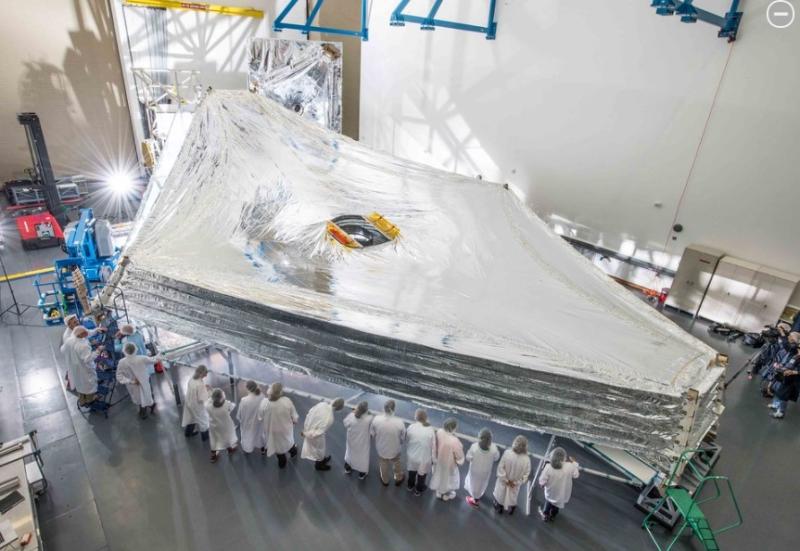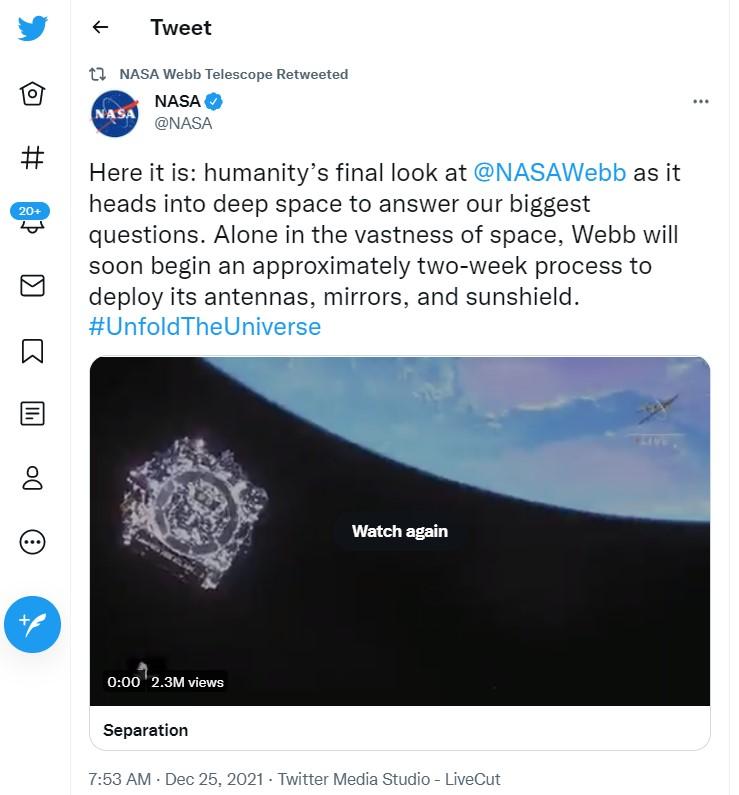The degree of technology complexity in the $10 billion James Webb Space Telescope mission is extraordinary by any measure, which made the December 25 perfect launch aboard an Ariane 5 rocket from French Guiana into space a relief for thousands of engineers and space scientists worldwide.
Still ahead, the telescope and affixed observatory must finish a 1-million-mile trip to L2 to orbit the sun before beginning months of tests to focus multiple hexagon-shaped mirrors into a single mirror with 100 times the power of the Hubble telescope.
The first two weeks for the Webb mission involve delicate maneuvers that engineers have described in calm tones. Calm tones --in public at least.
In just one example of the intricate steps involved in the design over the past two decades, NASA engineers described creating an elaborate sunshield to protect the sensitive Webb Space Telescope from damaging sun radiation.
The first phase of a five-day process to deploy the sunshield was completed Tuesday Dec. 28. By December 31, NASA reported the sunshield was taking shape.
The sunshield uses five layers of membranes each the size of a tennis court. They unfold atop one another to shield the delicate telescope from the sun, dropping the temperature by several hundred degrees. The telescope is designed to operate at about minus-370 degrees F. and even the space between the membrane layers allows a vacuum that serves as a good insulator.
Those membranes were folded up inside the Webb observatory launched Dec. 25 and began unfolding as early the third day of the mission sometime on Tuesday on schedule. To unfold the five industrial grade membranes, a series of 107 specially designed actuators each received a coordinated charge of electric current to melt a small wire inside of each actuator, allowing a spring to unwind and release the actuator device to begin the unfolding sequence. “The 107 MRDs (Membrane Release Devices) all have to work,” said James Cooper, a NASA engineer, in a pre-launch presentation over the web. Some engineers describe each actuator as a modified, high precision exploding bolt.
The unfolding process, along with the opening of the 22-foot telescope mirror made up of 18 hexagon segments happens over the first 10 days or so of the mission. It could take up to six months for tests of all the systems and to complete a process of coordinating the focal point of each hexagonal mirror into a single powerful focal point. The result will be about 100 times more powerful than the mirror in the Hubble telescope.
The five layers of the sun shield will limit the sun’s radiation and cool the atmosphere of the telescope to about minus 400 degrees F, the right environment for the delicate telescope to operate. All told, the five layers of membranes will cool down the heat from the sun by 500 degrees Fahrenheit, said Keith Parrish, senior NASA engineer. Another major factor in cooling is the way the telescope observatory is positioned, with the sunscreen always between the sun and the telescope adjusting position slightly as it orbits the sun.

It will take about 29 days from launch for Webb to reach the proper sun orbit at a position known as L2, but another six months before the first images emerge and a full year before scientists on Earth are able to receive precise data. The Webb telescope has a big advantage over Hubble because it can analyze infrared rays to detect signatures of various elements such as water or methane.
Scientists believe such insights can help discover the ingredients and processes in star formation. Thousands of astronomers have lined up research projects to investigate light coming from the edge of the universe that took more than 13 billion years to reach Webb because of the vast distance. There has been no shortage of superlatives from NASA administrators and officials from the European and Canadian space agencies – not to mention astronomy grad students at universities -- to express the potential value of the mission to better understanding basic science about how Earth was created and how human life was first possible. For some young astronomers, Webb offers the potential for research projects that could last their entire careers.
Shortly after the successful launch at 7:20 EST on December 25, the Webb telescope separated 27 minutes later from the final stage of the Ariane 5 rocket to head toward the sun. That separation inspired a loud round of applause from mission control engineers and scientists on the ground, which NASA replayed on Twitter showing actual video of the separation taken from the final rocket stage.

“Alone in the vastness of space, Webb swill soon begin an approximately two-week process to deploy its antennas, mirrors and sunshield,” NASA tweeted.
Editor’s Note: NASA has posted a “Where is Webb?” page that lays out a timeline for upcoming events, putting the sunshield deployment at day 3 of the mission, with the first of mirror deployments at 10 days.